
Station Name: NARBOROUGH & PENTNEY[Source: Glen Kilday]
Narborough & Pentney Station Gallery 1: 1910 - November 1975 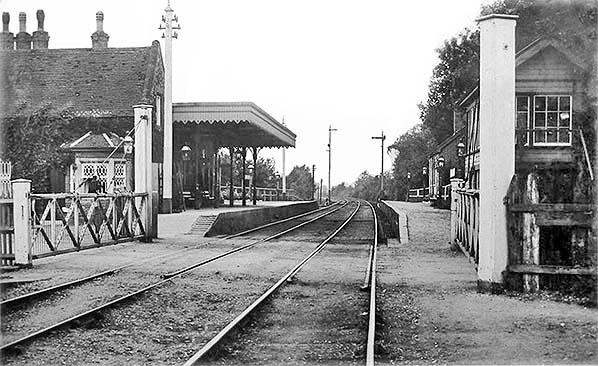 Looking through Narborough station towards Lynn about 1910. The ornate chimneys can be seen on the station building. The elaborate lozenge pattern in the window leading was typical of stations on the Lynn & Dereham Railway. The starter signal on the right-hand platform permitted up trains to use the crossing that can be seen beyond the signal: the line straight ahead was a long siding that ended beyond the bend in the tracks.
Copyright photo from John Alsop collection  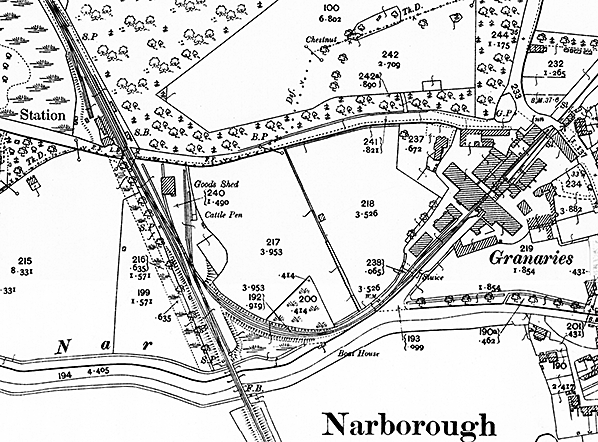
1905 25in OS map. The station and mill at Narborough can be seen on this map, with general goods facilities at each end of the station. A short siding runs behind the up platform at its north end. On the down platform the waiting room is shown with the signal box at the south end of the platform. LB indicates that the station had a post box. The majority of the goods facilities are on the south side of the crossing on the down side. There are four sidings, one running through the goods shed and one running alongside a cattle dock and pen. There was a 1-ton capacity crane somewhere in the yard at this time but it isn't shown on the map. The tightly curved branch to Everett’s mill diverges from the down line. Click here for a larger version.
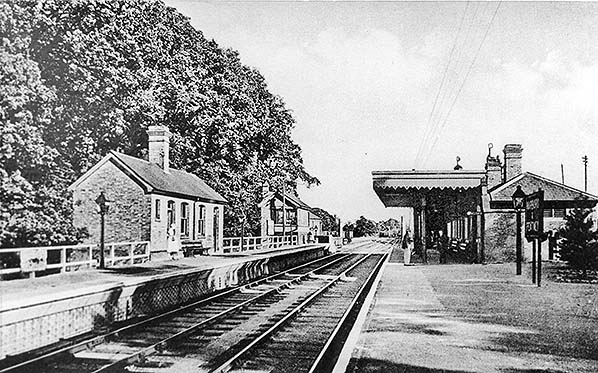
In this image from about 1930 the later full name of Narborough and Pentney is on the name boards. This view looks towards Dereham. A corner of the large goods shed can be seen on the left beyond the crossing. Trucks in the distance were near the siding that led to Everett’s extensive mill near Narborough village centre.
Copyright photo from John Alsop collection 2a.jpg) Station staff are posing for the camera in tis view looking north-west from the level crossing circa 1930s. An LNER poster advertises Exciting Holidays - Period Excursions to London.
Photo from John Mann collection 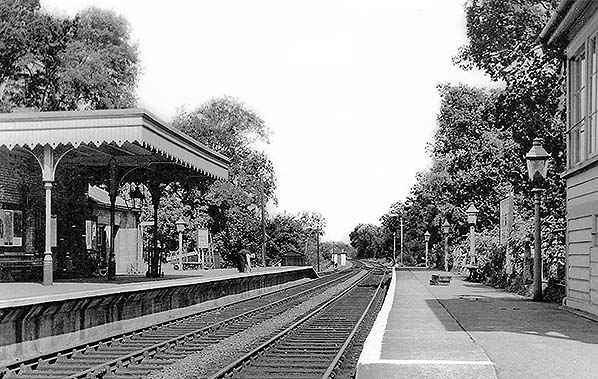 An undated picture of Narborough and Pentney station looking towards Lynn. The GER signal seen in an earlier image has been replaced with a more modern upper quadrant on a lower post. The posters on the canopied platform suggest a date in British Railways times. An undated picture of Narborough and Pentney station looking towards Lynn. The GER signal seen in an earlier image has been replaced with a more modern upper quadrant on a lower post. The posters on the canopied platform suggest a date in British Railways times.Photo from John Mann collection 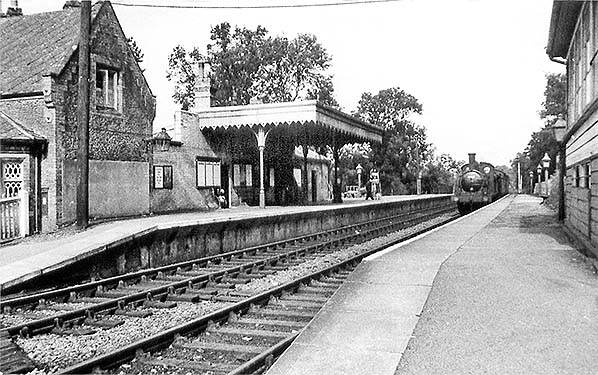
In this undated photograph taken in British Railways years at Narborough and Pentney, a J15 0-6-0 heads a goods train towards Dereham. The platform line had a signal for trains heading for Lynn and this goods train may have been using the long siding that paralleled the running line north of the station.
Photo from John Mann collection 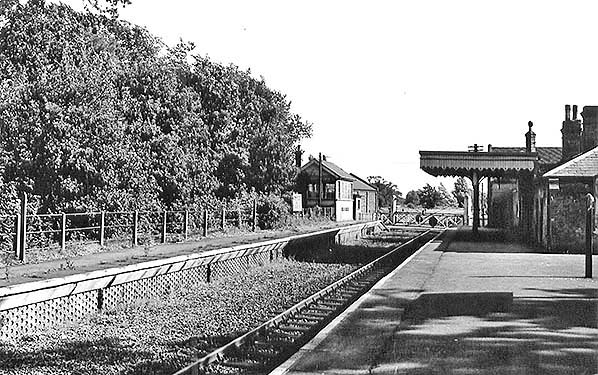
Narborough and Pentney station had a much reduced status when this image was captured in 1968. One of the running lines had gone and goods services withdrawn. The former sidings beyond the crossing were overgrown. The station buildings were intact and the ornate chimneys still in place.
Copyright photo from Stations UK 7a.jpg)
Narborough & Pentney station looking north-west from the level crossing in November 1975. The house is now in private occupation. It would appear from the windows and doors leaning against the wall that there has been some recent refurbishment of the house.
Photo
by David Burrows from his Flickr photostream
7b.jpg) Narborough & Pentney up platform in November 1976. Note the diamond pattern leading on the bay window; this design is found at many Lynn & Dereham stations. Narborough & Pentney up platform in November 1976. Note the diamond pattern leading on the bay window; this design is found at many Lynn & Dereham stations.Photo by David Burrows from his Flickr photostream Click here for Narborough & Pentney Station Gallery 2:
|
 The station building was close to the roadside. Its roof-line was at right-angles to the railway. A slate roof was laid to a diamond pattern and covered a building with beige brick corner pieces inset with knapped flint. Close to the platform an ornate 3-facet bay window had its own slate sub-roof. A small door, without a storm-porch, gave access to the building. On the west side a roomy platform canopy fronted a single-storey waiting room. Like the main building it had high ornate chimneys. The other platform had a large heated waiting room, probably, like elsewhere on the route, added later by the Great Eastern Railway. On 18 Feb 1880 an extension to Down platform was approved. A signal box was mounted on the east side platform beside the level crossing. That too was a GER addition: no signal boxes were provided when the line opened. The LNER later recorded Narborough as having a Saxby & Farmer 29-lever signal box.
The station building was close to the roadside. Its roof-line was at right-angles to the railway. A slate roof was laid to a diamond pattern and covered a building with beige brick corner pieces inset with knapped flint. Close to the platform an ornate 3-facet bay window had its own slate sub-roof. A small door, without a storm-porch, gave access to the building. On the west side a roomy platform canopy fronted a single-storey waiting room. Like the main building it had high ornate chimneys. The other platform had a large heated waiting room, probably, like elsewhere on the route, added later by the Great Eastern Railway. On 18 Feb 1880 an extension to Down platform was approved. A signal box was mounted on the east side platform beside the level crossing. That too was a GER addition: no signal boxes were provided when the line opened. The LNER later recorded Narborough as having a Saxby & Farmer 29-lever signal box. The station loop crossed the road at the level crossing. On the west side a short siding was shunted from the north and ended behind the platform. It was protected by a headshunt. The principal goods facilities lay south of the crossing, dominated by a large goods shed of brick and flint construction. It had one rail line through its length. There were three further sidings, one serving a cattle pen. They came off a goods loop on the east side of the running lines. The loop also provided access to a line on a tight left curve that led to sidings for Vynne and Everett’s large granary and mil
The station loop crossed the road at the level crossing. On the west side a short siding was shunted from the north and ended behind the platform. It was protected by a headshunt. The principal goods facilities lay south of the crossing, dominated by a large goods shed of brick and flint construction. It had one rail line through its length. There were three further sidings, one serving a cattle pen. They came off a goods loop on the east side of the running lines. The loop also provided access to a line on a tight left curve that led to sidings for Vynne and Everett’s large granary and mil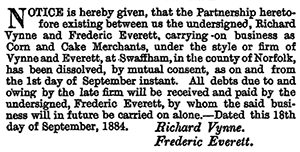 As he has done in regard to other stations on the line Stanley C Jenkins notes, in his book about the Lynn & Dereham, some facts about personnel at the station. In its early days Nebuchadnezzar Ayres was Station Master, working for East Anglian Railways. Around 1890 James Smith was in charge, succeeded by Thomas Read Nash. Charles Wilby was a long-serving chief who stayed from Edwardian days through the Great War years. Gabriel Paynter was in charge at the station in 1921 and was noted in the Great Eastern Railway Magazine as having hosted a New Year’s Eve dinner at the Ship Inn, perhaps indicating the importance of the Station Master in local society at the time.
As he has done in regard to other stations on the line Stanley C Jenkins notes, in his book about the Lynn & Dereham, some facts about personnel at the station. In its early days Nebuchadnezzar Ayres was Station Master, working for East Anglian Railways. Around 1890 James Smith was in charge, succeeded by Thomas Read Nash. Charles Wilby was a long-serving chief who stayed from Edwardian days through the Great War years. Gabriel Paynter was in charge at the station in 1921 and was noted in the Great Eastern Railway Magazine as having hosted a New Year’s Eve dinner at the Ship Inn, perhaps indicating the importance of the Station Master in local society at the time. 
 When the March 1882 timetable was published it showed a slight improvement in services. On Mondays only a 7.17am departure ran to Swaffham and then by way of Watton to Thetford. The tables create some confusion in its following columns. Not on Mondays an 8.08am Lynn departure called at Narborough at 8.30am bound for Thetford and Bury. However, on Saturdays, the Norwich market train, which by this time appeared in the timetable, left Lynn at 8.08am, occupied a similar but not identical path and served Narborough at 8.38am. Did the train divide at Swaffham on Saturdays? Or, did Not on Mondays also exclude Saturday in this case? For Dereham four further trains paused at Narborough each weekday, the 9.14am shown as Parliamentary. On Tuesdays a train for Norwich called at 8.44pm and finally, on Mondays, a mixed called by at 9.20pm. Up trains began at 8.30am but only on Tuesday. A mixed for Lynn at 9.25am did not run on Tuesdays. At 10.56am an up train connected with a Parliamentary at Lynn, bound, according to a footnote, for St Pancras and Liverpool Street stations in London. Lynn was served by an extra train at 11.43am on Tuesdays and four further weekday trains followed, the last from Bury and Thetford. Sundays trains were no more.
When the March 1882 timetable was published it showed a slight improvement in services. On Mondays only a 7.17am departure ran to Swaffham and then by way of Watton to Thetford. The tables create some confusion in its following columns. Not on Mondays an 8.08am Lynn departure called at Narborough at 8.30am bound for Thetford and Bury. However, on Saturdays, the Norwich market train, which by this time appeared in the timetable, left Lynn at 8.08am, occupied a similar but not identical path and served Narborough at 8.38am. Did the train divide at Swaffham on Saturdays? Or, did Not on Mondays also exclude Saturday in this case? For Dereham four further trains paused at Narborough each weekday, the 9.14am shown as Parliamentary. On Tuesdays a train for Norwich called at 8.44pm and finally, on Mondays, a mixed called by at 9.20pm. Up trains began at 8.30am but only on Tuesday. A mixed for Lynn at 9.25am did not run on Tuesdays. At 10.56am an up train connected with a Parliamentary at Lynn, bound, according to a footnote, for St Pancras and Liverpool Street stations in London. Lynn was served by an extra train at 11.43am on Tuesdays and four further weekday trains followed, the last from Bury and Thetford. Sundays trains were no more.
 In the 1932 Working Timetable Narborough and Pentney’s down daily goods called from 8.23am to 8.35am. Except on Tuesdays and Saturdays a Class D goods was there from 12.35pm to 1.10pm: on Saturdays it made a briefer stop from 1.35pm to 1.45pm, whilst a Tuesday train called, Class B, only if required and leaving at 6.30pm. The up daily goods called from 10.05am to 10.20am. The 2.15pm from Roudham Junction called at 4.35pm on Saturdays and at 6.35pm, if required, Mondays to Fridays. On Saturday evenings the 12.50pm goods from Norwich paused from 7.08pm until 7.20pm. Other weekdays saw the 2.30pm from Dereham, having taken five and a half hours to reach Narborough and Pentney, arrive at 8.00pm, where it was overtaken by the
In the 1932 Working Timetable Narborough and Pentney’s down daily goods called from 8.23am to 8.35am. Except on Tuesdays and Saturdays a Class D goods was there from 12.35pm to 1.10pm: on Saturdays it made a briefer stop from 1.35pm to 1.45pm, whilst a Tuesday train called, Class B, only if required and leaving at 6.30pm. The up daily goods called from 10.05am to 10.20am. The 2.15pm from Roudham Junction called at 4.35pm on Saturdays and at 6.35pm, if required, Mondays to Fridays. On Saturday evenings the 12.50pm goods from Norwich paused from 7.08pm until 7.20pm. Other weekdays saw the 2.30pm from Dereham, having taken five and a half hours to reach Narborough and Pentney, arrive at 8.00pm, where it was overtaken by the  Despite BR’s modernisation attempts the end was signalled in Dr. Richard Beeching’s report The Reshaping of Britain’s Railways, published in March 1963 and closure of Norfolk’s branch lines began with some urgency. Additionally services on the Lynn & Dereham were run down by closure of general goods facilities at intermediate stations from 13 July 1964. At Narborough a private siding remained in use after that date. From 15 August 1966 Narborough and Pentney became an unstaffed halt for the first time - some other stations had been so for some years in the 1860s and 70s. The station’s passing loop was removed leaving only the former up platform in use. Closure notices were served in 1968 and the line, including Narborough and Pentney station, closed to passengers with effect from 9 September 1968, with the last trains running on Saturday 7 September. A private siding did remain in use for a short time after that date.
Despite BR’s modernisation attempts the end was signalled in Dr. Richard Beeching’s report The Reshaping of Britain’s Railways, published in March 1963 and closure of Norfolk’s branch lines began with some urgency. Additionally services on the Lynn & Dereham were run down by closure of general goods facilities at intermediate stations from 13 July 1964. At Narborough a private siding remained in use after that date. From 15 August 1966 Narborough and Pentney became an unstaffed halt for the first time - some other stations had been so for some years in the 1860s and 70s. The station’s passing loop was removed leaving only the former up platform in use. Closure notices were served in 1968 and the line, including Narborough and Pentney station, closed to passengers with effect from 9 September 1968, with the last trains running on Saturday 7 September. A private siding did remain in use for a short time after that date.
 Home Page
Home Page